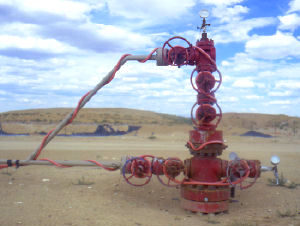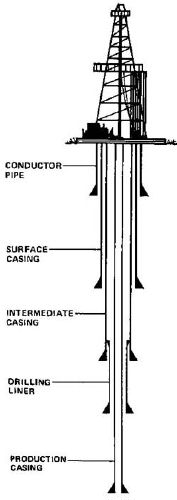
Oil and Gas Well Drilling and Servicing eTool
Home | Site Preparation | Drilling | Well Completion | Servicing | Plug and Abandon Well | General Safety and Health
Site Map | Glossary of Terms | Illustrated Glossary

Figure 1. A plugged and abandoned well site
A well is abandoned when it reaches the end of its useful life or is a dry hole.
- The casing and other equipment is removed and salvaged.
- Cement plugs are placed in the borehole to prevent migration of fluids between the different formations.
- The surface is reclaimed.
Hazards may be related to the following:

Figure 2. Wellhead
The rig is used to remove the casing and plug the well. The wellhead is removed. After the casing is cut off, it is removed.
Potential Hazards:
- Being struck by rig equipment (such as casing jacks, power tongs, and casing elevators).
- Being exposed to other hazards similar to those encountered during regular drilling or workover operations.
Possible Solutions:
- Solutions are similar to those found in Tripping Out/In and Casing Operations.
Cement plugs are placed in the borehole to prevent migration of fluids between the different formations. This also prevents the migration of gas or fluids to the surface.
Potential Hazards:
- Being struck by pressured lines when pumping cement.
Possible Solutions:
- Instruct personnel to stand clear of pressurized lines.
Additional Information:
- Bulletin E3, Well Abandonment and Inactive Well Practices for U.S. Exploration and Production Operations. American Petroleum Institute (API) Environmental Guidance Document, (2000, June). Addresses the environmental concerns related to well abandonment and inactive well practices including protection of freshwater aquifers from fluid migration; isolation of hydrocarbon production and water injection intervals. Additional issues in the document include protection of surface soils and surface waters, future and use, and permanent documentation of plugged and abandoned wellbore locations and conditions.
#56. Surface Casing
Usually the first casing to be run in a well. This is done after spudding-in so a blowout preventer can be installed before drilling is started.†

 Translate
Translate